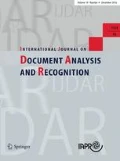Abstract
A method of stroke extraction based on ambiguous zone detection is presented to facilitate the recovery of dynamic information from static handwritten Chinese character images. First, ambiguous zones are detected using feature points of the skeleton and the contour information around them. Then, a graph is built to represent each character, and the continuity of sub-strokes is analyzed using Bayesian classification. Several constraint conditions are proposed to search stroke paths in the graph and two criteria are also utilized to deal with multi-traced sub-strokes. Finally, strokes are reconstructed by B-spline interpolation. Experimental results show that the proposed method can detect the ambiguous zones accurately, and is feasible and effective for stroke extraction.
Similar content being viewed by others
References
Cao, R., Tan, C.L.: A model of stroke extraction from chinese character images. In: The 15th International Conference on Pattern Recognition, vol. 4, pp. 368–371. IEEE Computer Society, Barcelona (2000)
Cao, Z., Su, Z., Wang, Y.: A model for recovering writing sequence from offline handwritten chinese character image. In: The 2008 International Congress on Image and Signal Processing, vol. 1, pp. 298–302. IEEE Computer Society, Sanya (2008)
Cheng F.H.: Multi-stroke relaxation matching method for handwritten chinese character recognition. Pattern Recognit. 31(4), 401–410 (1998)
Chouinard C., Plamondon R.: Thinning and segmenting handwritten characters by line following. Mach. Vis. Appl. 5(3), 185–197 (1992)
Cooper G.F., Herskovits E.: A bayesian method for the induction of probabilistic networks from data. Mach. Learn. 9(4), 309–347 (1992)
Fan K.C., Wu W.H.: A run-length-coding-based approach to stroke extraction of chinese characters. Pattern Recognit. 33(11), 1881–1895 (2000)
Freeman H.: Computer processing of line-drawing images. Comput. Surv. 6(1), 57–97 (1974)
Hsieh C.C., Lee H.J.: A probabilistic stroke-based viterbi algorithm for handwritten chinese character recognition. Int. J. Pattern Recognit. Artif. Intell. 7(2), 329–352 (1993)
Huang, T., Yasuhara, M.: A total stroke slalom method for searching for the optimal drawing order of off-line handwriting. In: IEEE International Conference on Systems, Man and Cybernetics, vol. 3, pp. 2789–2794 (1995)
Jäger, S.: Recovering writing traces in off-line handwriting recognition: using a global optimization technique. In: 13th International Conference on Pattern Recognition, pp. 150–154. Vienna (1996)
Kim I.J., Kim J.H.: Statistical character structure modeling and its application to handwritten chinese character recognition. IEEE Trans. Pattern Anal. Mach. Intell. 25(11), 1422–1436 (2003)
Lam L., Lee S.W., Suen C.Y.: Thinning methodologies-a comprehensive survey. IEEE Trans. Pattern Anal. Mach. Intell. 14(9), 869–885 (1992)
Lee C., Wu B.: A chinese-character-stroke-extraction algorithm based on contour information. Pattern Recognit. 31(6), 651–663 (1998)
Lee H.J., Chen B.: Recognition of handwritten chinese characters via short line segments. Pattern Recognit. 25(5), 543–552 (1992)
Leung C.H., Cheung Y.S., Wong Y.L.: A knowledge-based stroke-matching method for chinese character recognition. IEEE Trans. syst. Man Cybern. 17(6), 993–1003 (1987)
Liu C.L., Kim I.J., Kim J.H.: Model-based stroke extraction and matching for handwritten chinese character recognition. Pattern Recognit. 34(12), 2339–2352 (2001)
Liu K., Huang Y.S., Suen C.Y.: Identification of fork points on the skeletons of handwritten chinese characters. IEEE Trans. Pattern Anal. Mach. Intell. 21(10), 1095–1100 (1999)
Neapolitan R.E.: Learning Bayesian Networks. Prentice Hall, Upper Saddle River, NJ (2004)
Nel E.M., du Preez J.A., Herbst B.: Estimating the pen trajectories of static signatures using hidden markov models. IEEE Trans. Pattern Anal. Mach. Intell. 27(11), 1733–1746 (2005)
Plamondon R., Privitera C.M.: The segmentation of cursive handwriting: An approach based on off-line recovery of the motor-temporal information. IEEE Trans. Image Process. 8(1), 80–91 (1999)
Qiao Y., Nishiara M., Yasuhara M.: A framework toward restoration of writing order from single-stroked handwriting image. IEEE Trans. Pattern Anal. Mach. Intell. 28(11), 1724–1737 (2006)
Qiao Y., Yasuhara M.: Recovering dynamic information from static handwritten images. In: The 9th International Workshop on Frontiers in Handwriting Recognition, pp. 118–123. IEEE Computer Society, Tokyo (2004)
Shaikh, N.A., Shaikh, Z.A.: A generalized thinning algorithm for cursive and non-cursive language scripts. In: The 9th IEEE International Multi-topic Conference, pp. 1–4. Karachi (2005)
Shi D., Gunn S., Damper R.: Handwritten chinese radical recognition using nonlinear active shape models. IEEE Trans. Pattern Anal. Mach. Intell. 25(2), 277–280 (2003)
Shi D., Gunn S.R., Damper R.I.: Handwritten chinese character recognition using nonlinear active shape models and the viterbi algorithm. Pattern Recognit. Lett. 23(14), 1853–1862 (2002)
Su T., Zhang T., Guan D.: Corpus-based hit-mw database for offline recognition of general-purpose chinese handwritten text. Int. J. Doc. Anal. Recognit. 10(1), 27–38 (2007)
Su Y.M., Wang J.F.: A novel stroke extraction method for chinese characters using gabor filters. Pattern Recognit. 36(3), 635–647 (2003)
Zou J.J., Yan H.: Skeletonization of ribbon-like shapes based on regularity and singularity analyses. IEEE Trans. syst. Man Cybern. 31(3), 401–407 (2001)
Author information
Authors and Affiliations
Corresponding author
Rights and permissions
About this article
Cite this article
Su, Z., Cao, Z. & Wang, Y. Stroke extraction based on ambiguous zone detection: a preprocessing step to recover dynamic information from handwritten Chinese characters. IJDAR 12, 109–121 (2009). https://doi.org/10.1007/s10032-009-0085-9
Received:
Revised:
Accepted:
Published:
Issue Date:
DOI: https://doi.org/10.1007/s10032-009-0085-9




